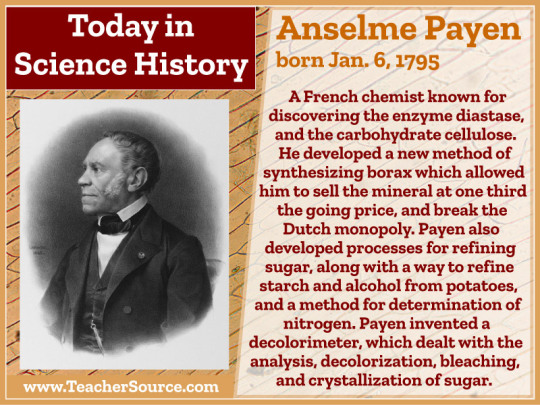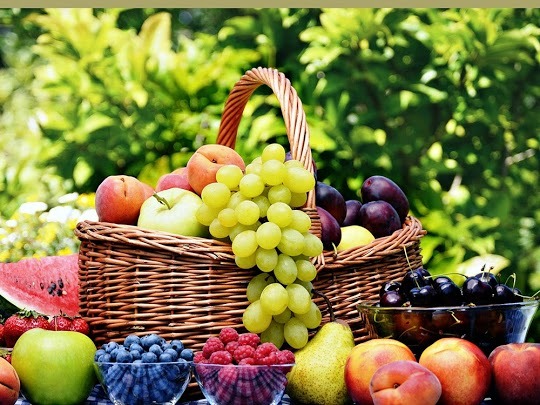#anselme payen
Photo

Anselme Payen was born on January 6, 1795. A French chemist known for discovering the enzyme diastase, and the carbohydrate cellulose. He developed a new method of synthesizing borax which allowed him to sell the mineral at one third the going price, and break the Dutch monopoly. Payen also developed processes for refining sugar, along with a way to refine starch and alcohol from potatoes, and a method for determination of nitrogen. Payen invented a decolorimeter, which dealt with the analysis, decolorization, bleaching, and crystallization of sugar.
#anselme payen#chemistry#diatase#cellulose#inventors#borax#science#science history#science birthdays#on this day#on this day in science history
3 notes
·
View notes
Text

3 notes
·
View notes
Text
Nanocellulose in Food Science and Technology - Potential, Advantages and Gaps of Research_Crimson Publishers
Nanocellulose in Food Science and Technology - Potential, Advantages and Gaps of Research by Talita Szlapak Franco in Food science
Since the first description of cellulose molecule in 1838 by the French chemist Anselme Payen, passing through the obtention of nanocellulose in 1977 [1], until the published researches up to 2017, too many advances and different approaches were given to this multifunctional polysaccharide from pulp and paper industry to medical applications. Although the first US Patent submitted by Turbak and co-workers considered nanocellulose a food additive, this product was not commercially exploited because of the high production costs, however, now this panorama is changing with industries focusing their plants in the production of the nanopolymer [2].
https://crimsonpublishers.com/ntnf/fulltext/NTNF.000514.php

For more open access journals in Crimson publishers please click on the link https://crimsonpublishers.com/
For more articles in food science please click on the link https://crimsonpublishers.com/ntnf/
40 notes
·
View notes
Text
Top #tweeted story in #structbio: Dr Yoshiharu Nishiyama is the 2021 Anselme Payen Award winner - Cellulose and Renewable Materials https://bit.ly/3DqhCO0, see more https://bit.ly/3NixBSQ
Top #tweeted story in #structbio: Dr Yoshiharu Nishiyama is the 2021 Anselme Payen Award winner - Cellulose and Renewable Materials https://bit.ly/3DqhCO0, see more https://bit.ly/3NixBSQ
— Fabrice Leclerc (@rnomics) Mar 28, 2022
from Twitter https://twitter.com/rnomics
March 28, 2022 at 04:07PM
via IFTTT
0 notes
Photo










Il était une fois une saison végétale à l’EHPAD Anselme Payen, à l’invitation du Fond d’Art Contemporain Paris-Collection.
Créer avec les résidents un climat végétal poétique et stimulant.
L’éveil de nature toujours central.
Merci Sippa, la belle équipe, et Y, Y, L et myA*!*
1 note
·
View note
Text
Nanocellulose in Food Science and Technology - Potential, Advantages and Gaps of Research_Crimson publishers

Since the first description of cellulose molecule in 1838 by the French chemist Anselme Payen, passing through the obtention of nanocellulose in 1977 [1], until the published researches up to 2017, too many advances and different approaches were given to this multifunctional polysaccharide from pulp and paper industry to medical applications. Although the first US Patent submitted by Turbak and co-workers considered nanocellulose a food additive, this product was not commercially exploited because of the high production costs, however, now this panorama is changing with industries focusing their plants in the production of the nanopolymer [2].
For more open access journals in Crimson publishers please click on the link https://crimsonpublishers.com/
For more articles in food science please click on the link https://crimsonpublishers.com/ntnf/
0 notes
Text
Celulose
Definição
A celulose é a principal substância encontrada nas paredes celulares das plantas e ajuda a planta a permanecer rígida e forte.
Os seres humanos não podem digerir celulose, mas é importante na dieta como fonte de fibra.
A celulose é uma substância que existe nas paredes celulares das plantas e é usada para fazer papel, plástico e vários tecidos e fibras.
Celulose – O que é
A celulose (C6H10O5)n é um composto orgânico e o biopolímero mais abundante na Terra.
É um carboidrato complexo ou polissacarídeo que consiste em centenas a milhares de moléculas de glicose, ligadas entre si para formar uma cadeia. Enquanto os animais não produzem celulose, ela é produzida por plantas, algas e algumas bactérias e outros micro-organismos.
A celulose é a principal molécula estrutural nas paredes celulares de plantas e algas.
Celulose – Molécula
A celulose é uma molécula composta de carbono, hidrogênio e oxigênio e é encontrada na estrutura celular de praticamente toda a matéria vegetal.
Este composto orgânico, considerado o mais abundante na terra, é até excretado por algumas bactérias.
A celulose fornece estrutura e resistência às paredes celulares das plantas e fornece fibra em nossas dietas. Embora alguns animais, como os ruminantes, possam digerir celulose, os humanos não podem.
A celulose se enquadra na categoria de carboidratos indigestíveis, conhecidos como fibras alimentares.
Nos últimos anos, a celulose tornou-se um aditivo alimentar popular devido às suas propriedades físicas e químicas únicas quando combinada com água. Embora a celulose possa ser encontrada na maioria das matérias vegetais, as fontes mais econômicas de celulose industrial são o algodão e a polpa de madeira.
Celulose – Carboidrato
Celulose, um carboidrato complexo ou polissacarídeo, consistindo em 3.000 ou mais unidades de glicose.
O componente estrutural básico das paredes celulares das plantas, a celulose compreende cerca de 33% de toda a matéria vegetal (90% do algodão e 50% da madeira são celulose) e é o mais abundante de todos os compostos orgânicos que ocorrem naturalmente.
Não digerível pelo homem, a celulose é um alimento para animais herbívoros (por exemplo, vacas, cavalos) porque eles a retêm por tempo suficiente para digestão por micro-organismos presentes no trato alimentar; protozoários no intestino de insetos como cupins também digerem celulose.
De grande importância econômica, a celulose é processada para produzir papéis e fibras e é quimicamente modificada para produzir substâncias usadas na fabricação de itens como plásticos, filmes fotográficos e rayon.
Outros derivados da celulose são usados como adesivos, explosivos, agentes espessantes para alimentos e em revestimentos à prova de umidade.
Como a celulose é útil?
A celulose é uma molécula, composta por centenas – e às vezes até milhares – de átomos de carbono, hidrogênio e oxigênio.
A celulose é a substância principal nas paredes das células vegetais, ajudando as plantas a permanecerem rígidas e na vertical.
Os seres humanos não podem digerir celulose, mas é importante na dieta como fibra. A fibra auxilia o sistema digestivo – mantendo os alimentos em movimento através do intestino e empurrando os resíduos para fora do corpo.
Animais, como vacas, ovelhas e cavalos, podem digerir celulose, e é por isso que eles podem obter a energia e os nutrientes de que precisam da grama.
A celulose tem muitos usos. No algodão, faz roupas como camisetas e jeans. A fabricação de papel precisa de grandes quantidades de celulose, obtida principalmente da madeira.
Estrutura de celulose
Como o amido, a celulose é composta por uma longa cadeia de pelo menos 500 moléculas de glicose. A celulose é, portanto, um polissacarídeo (em latim para “muitos açúcares”).
Várias dessas cadeias de polissacarídeos estão dispostas em matrizes paralelas para formar microfibrilas de celulose. As cadeias individuais de polissacarídeos são ligadas nas microfibrilas por ligações de hidrogênio.
As microfibrilas, por sua vez, são agrupadas para formar macrofibrilas.
As microfibrilas da celulose são extremamente resistentes e inflexíveis devido à presença de ligações de hidrogênio.
De fato, ao descrever a estrutura das microfibrilas de celulose, os químicos chamam seu arranjo de cristalino, o que significa que as microfibrilas têm propriedades semelhantes a cristais.
Embora o amido tenha a mesma estrutura básica da celulose – também é um polissacarídeo – as subunidades da glicose são ligadas de maneira a permitir que a molécula de amido torça.
Em outras palavras, a molécula de amido é flexível, enquanto a molécula de celulose é rígida.
Como a celulose é usada nos alimentos
Suplemento de fibra: Com a crescente conscientização sobre a ingestão de fibra, a celulose se tornou um dos aditivos alimentares mais populares.
A adição de celulose aos alimentos permite um aumento no volume e no teor de fibras sem um grande impacto no sabor. Como a celulose se liga e se mistura facilmente com a água, ela é frequentemente adicionada para aumentar o teor de fibras de bebidas e outros itens líquidos quando a textura áspera dos suplementos regulares de fibra seria indesejável.
Redutor de calorias: a celulose fornece muito volume ou volume de alimentos, mas, como não é digerível aos seres humanos, não possui valor calórico. Por esse motivo, a celulose tornou-se um agente de volume popular em alimentos dietéticos. Os consumidores que comem alimentos com alto teor de celulose se sentem cheios física e psicologicamente sem consumir muitas calorias.
Espessamento/Emulsificação: A ação gelificante da celulose, quando combinada com a água, fornece qualidades de espessamento e estabilização no alimento ao qual é adicionado.
O gel de celulose age de maneira semelhante a uma emulsão, suspendendo os ingredientes dentro de uma solução e impedindo a separação da água.
A celulose é frequentemente adicionada aos molhos para a ação espessante e emulsificante.
O poder de espessamento da celulose também permite que mais ar seja chicoteado em produtos como sorvete ou cobertura chicoteada.
A celulose permite a produção de alimentos espessos e cremosos sem o uso de tanta gordura.
Anti-empacotamento: a capacidade da celulose de absorver a umidade e revestir os ingredientes em um pó fino faz dele o ingrediente preferido para aplicações anti-empacotamento. Queijos ralados e ralados, misturas de especiarias e misturas de bebidas em pó são apenas alguns dos muitos itens alimentares que aproveitam a celulose como um agente antiaglomerante.
História
O químico francês Anselme Payen descobriu e isolou a celulose em 1838. Payen também determinou a fórmula química.
Em 1870, o primeiro polímero termoplástico, celuloide, foi produzido pela Hyatt Manufacturing Company usando celulose.
A partir daí, a celulose foi usada para produzir rayon na década de 1890 e celofane em 1912.
Hermann Staudinger determinou a estrutura química da celulose em 1920.
Em 1992, Kobayashi e Shoda sintetizaram celulose sem usar enzimas biológicas.
Fonte: www.bbc.co.uk/https://ift.tt/2Z0wlgs
O post Celulose apareceu primeiro em Portal São Francisco.
Celulose Publicado primeiro em https://www.portalsaofrancisco.com.br/
Este conteúdo apareceu primeiro em: https://ift.tt/2E4forM
0 notes
Text
Cellulose Acetate is eco-friendly plastic which is harmless to body and health
Cellulose is the main substance found in plant cell long-chain polymer of glucose molecules joined together. It is mainly used in the making of Paper and it is an organic compound. It is not digested by Human Being, but it is our source of fiber. Cellulose was found in 1838 by the French chemist Anselme Payen, who detached it from plant matter and decided its synthetic recipe. In 1865, Paul Schützenberger found that cellulose responds with acidic anhydride to frame cellulose acetic acid derivation.
The German chemists Arthur Eichengrün and Theodore Becker developed the primary solvent types of cellulose acetic acid derivation in 1903. Cellulose Acetate is used in Film Base for photography. It is also used in play card and Cigarette filter making. It is also used in eyeglass frame material maker. Cellulose acetic fiber, one of the soonest manufactured fibers, depends on cotton or tree mash cellulose (biopolymers).
According to Hexaresearch Report Global cellulose acetate market is expected to grow due to the development in global cigarette production. Availability of cellulose acetate in a wide range of colors and its unique properties such as good resistance to chemicals, high dielectric constant, and high mechanical strength makes it suitable for manufacturing a wide range of consumer products such as plastic films, textiles, and separation membrane. Among all the various applications, cigarette filters command around 80% of the market share and are the key revenue contributor to the market. However, with the implementation of government regulations to ban public smoking in countries such as Russia and China and presence of alternatives such as electronic cigarettes in the market, is expected to affect the growth potential of the market.
Cellulose acetate tow accounted for the largest product type segment commanding a share of 81.69% in 2016. It is a primary component used for the manufacturing of cigarette filters and extruded plastics.
Cellulose acetate filament is used to produce fabrics, which is mostly used in the textile industry. The filament’s use in the textile & apparel industry is expected to grow owing to its properties such as good textile processing performance. Other applications for the filament include its usage in medical gauze, ribbons, home furnishings, tricot knits, circular knits, men’s linings, and coffin linings.
Access full report or request for a free sample at: https://www.hexaresearch.com/research-report/cellulose-acetate-market
0 notes
Link
via Twitter https://twitter.com/oneclipsesci
0 notes
Video
youtube
What is CELLULOSE? What does CELLULOSE mean? CELLULOSE meaning - CELLULOSE pronunciation - CELLULOSE definition - CELLULOSE explanation - How to pronounce CELLULOSE? Source: Wikipedia.org article, adapted under http://ift.tt/yjiNZw license. Cellulose is an organic compound with a polysaccharide consisting of a linear chain of several hundred to many thousands of linked D-glucose units. Cellulose is an important structural component of the primary cell wall of green plants, many forms of algae and the oomycetes. Some species of bacteria secrete it to form biofilms. Cellulose is the most abundant organic polymer on Earth. The cellulose content of cotton fiber is 90%, that of wood is 40–50% and that of dried hemp is approximately 57%. Cellulose is mainly used to produce paperboard and paper. Smaller quantities are converted into a wide variety of derivative products such as cellophane and rayon. Conversion of cellulose from energy crops into biofuels such as cellulosic ethanol is under investigation as an alternative fuel source. Cellulose for industrial use is mainly obtained from wood pulp and cotton. Some animals, particularly ruminants and termites, can digest cellulose with the help of symbiotic micro-organisms that live in their guts, such as Trichonympha. In humans, cellulose acts as a hydrophilic bulking agent for feces and is often referred to as a "dietary fiber". Cellulose was discovered in 1838 by the French chemist Anselme Payen, who isolated it from plant matter and determined its chemical formula. Cellulose was used to produce the first successful thermoplastic polymer, celluloid, by Hyatt Manufacturing Company in 1870. Production of rayon ("artificial silk") from cellulose began in the 1890s and cellophane was invented in 1912. Hermann Staudinger determined the polymer structure of cellulose in 1920. The compound was first chemically synthesized (without the use of any biologically derived enzymes) in 1992, by Kobayashi and Shoda.
0 notes